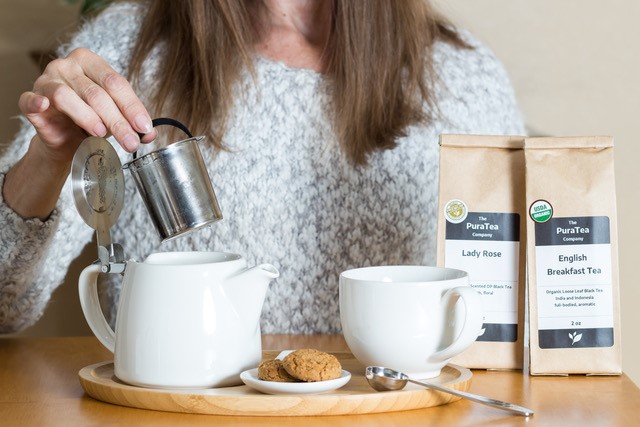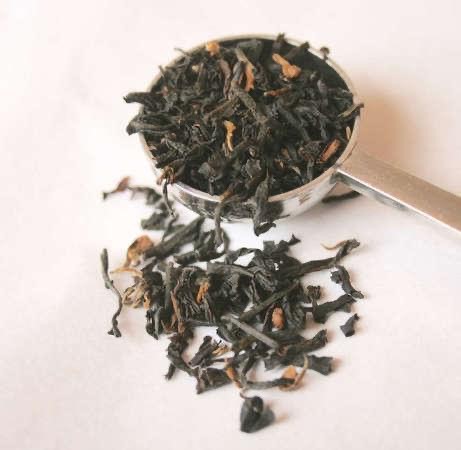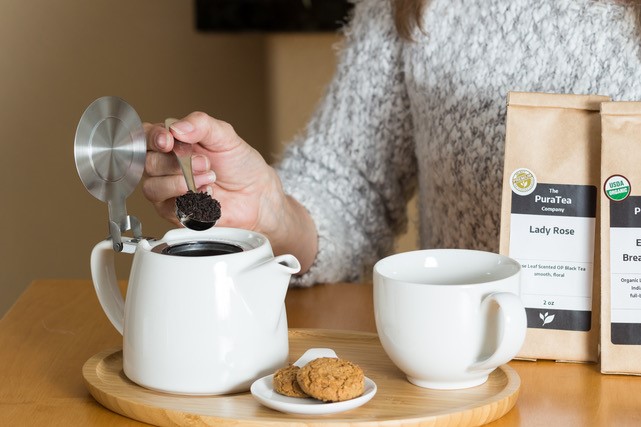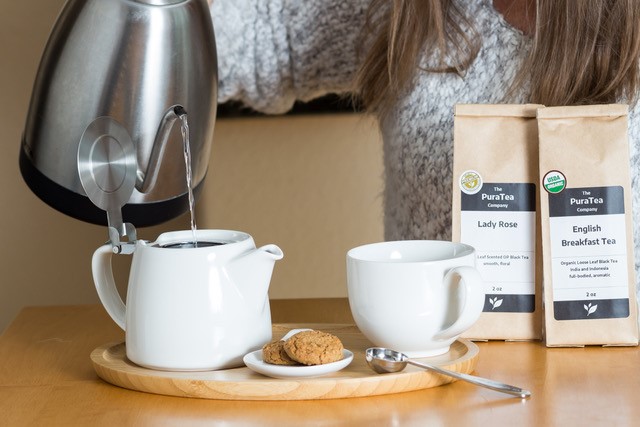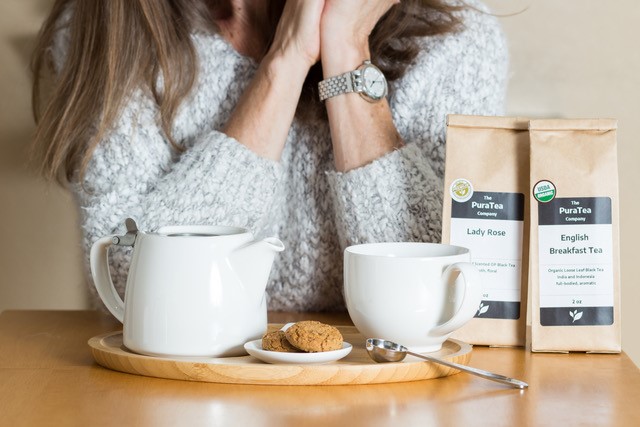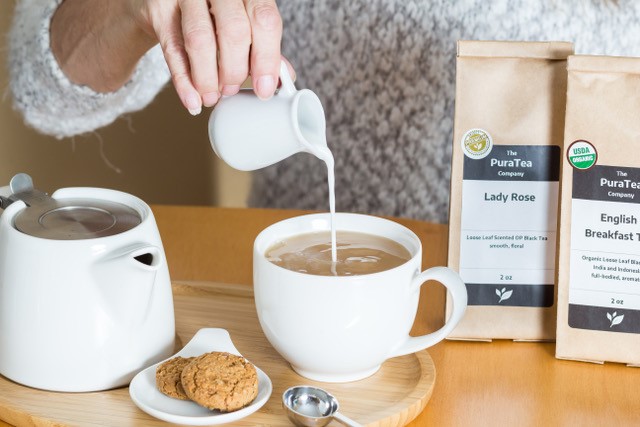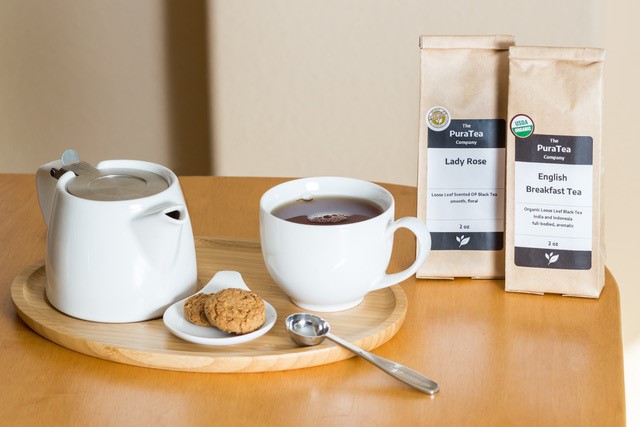Brewing a pot of delicious loose leaf tea is the process of extracting the flavors and nutrients from the leaves of the tea plant. It requires steeping the leaves in freshly drawn water that is heated to the correct temperature for each individual tea. It is well recognized that loose leaf tea makes the best cup of tea, much due to the higher quality, freshness and better flavor.
There are various styles of brewing tea, two popular methods are the eastern and the western styles.
The Chinese (Eastern) Gong Fu method often uses a gaiwan and tends to use more tea, less water and quick, multiple brews. The multiple brews, which are slightly longer each time, extract different flavors from the leaf with each infusion. Sometimes you prefer the first brew, others the third.
I was once told by a Chinese tea merchant in Seattle that the first brew is for the tea pet, the second for the wife and the third infusion he enjoys! Having enjoyed this method of brewing at a tea shop in London, England I can say I really enjoyed experiencing the differing flavors that resulted from multiple infusions from the exact same tea leaves. However, I was high on caffeine after enjoying numerous brews!
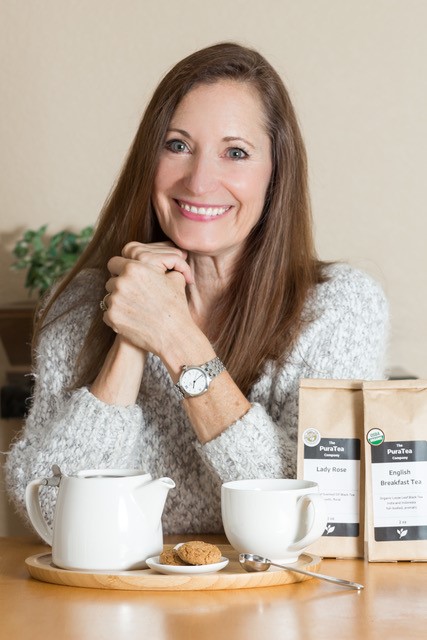
The western style of brewing uses less tea, more water and longer brewing times and is usually brewed in a teapot or mug. This style of brewing extracts as much flavor as possible in one infusion. However, even with the western brew some teas may be re-brewed which can bring out more subtle flavors. Once tea leaves have been placed in water they should be used within 3 hours. You may also tip them out onto a plate and allow them to dry thus you could use these the next day.
In this article we are discussing the western method of brewing tea. So, for those beginning their loose leaf tea journey and for those more experienced tea drinkers, here are the basics, and a few secrets, of brewing.
The Recipe
So the recipe for a great cup of tea is simple, it just takes a little time to perfect.
- Teaware
- Quality loose leaf tea
- Freshly drawn water at the appropriate temperature for each tea type
- The correct steeping time for your particular tea
Teaware
The easiest way to brew tea is either in a teapot or mug which has a basket infuser that can be removed. This way the tea does not over brew and become bitter. I prefer not to use a tea ball as it does not allow the tea to expand and release the full flavor from the leaf.
Tip: Prior to making the tea, warm the teapot or mug. Pour hot water in and swirl around before discarding. This will ensure your tea stays hot longer.
Loose Leaf Tea
Good quality, loose leaf orthodox tea is grown and produced using traditional methods such as hand plucking and processing (withering, rolling, oxidation and drying). ). It also contains a higher concentration of the health benefits associated with tea. Types of tea are black, pu-erh, green, oolong and white. The advantage of loose leaf is you can use as much or as little as your taste buds desire.
As a dried product tea enjoys a long shelf life, however, once opened it does absorb both moisture and strong odors such as spices. Store in its resealable bag or an airtight container away from moisture, heat, light and odors. A popular container is a metal tea caddy with a well-sealed lid.
Tip: Do not store your tea in your spice cupboard!
How Much Tea?
The quick answer to this question is a long-standing rule of thumb which says one teaspoon of loose leaf tea for each 6-8oz of water. This rule works well for many teas, but of course, there are always exceptions. The larger whole leaf teas such as a delicate white, being more airy and having more volume, may take more than 1 tsp for a good flavorful cup.
You may also measure your tea by weight using 2-2.5 grams of tea for a 6 oz cup. But, most of us really don’t want to be that precise.
Personally I always use the same two dedicated tea measuring spoons (1tsp and 1tbsp) to achieve a consistent cup of tea every time. Also when I find my favorite brew for a particular tea I take note. That’s why I added a line on our packaging back label that says “My Brew”. This allows you to jot down how you enjoy that particular tea.
Tip: Don’t get caught up in rules, these are guidelines. Experiment and use the amount of tea YOU like.
Water Quality and Temperature
A large part of your tea is water so the quality and temperature are important. Always use freshly drawn water heated to the correct temperature for the tea you are brewing.
I use filtered tap water. Filtered because normal tap water has too high a mineral count and chlorine level so the water, and thus your tea, tastes better using a filter. If your water is hard and you don't like the taste, why would you make tea with it?
For tea geeks we use freshly drawn water each time because re-boiling water reduces the oxygen level in the water and that affects the flavor of the tea.
Water that is too hot can burn the tea leaves and spoil the flavor. For instance, green tea leaves are very delicate and pouring boiling water on them will damage them, resulting in a bitter taste. Wait a short while for the water to cool off a little or use a kettle that heats to various temperatures. This will ensure the tea leaves don’t burn.
There are some great electric tea kettles on the market that will brew your water to various set temperatures for the different types of teas. Personally I like the goose neck design as it offers a more precise pour.
A point worth mentioning is that, whilst the boiling point of water at sea level is 212°F (100°C), for every 500ft increase in elevation from sea level, the boiling point is lowered by almost one degree. This means that in Colorado, living at an elevation of some 5500ft (1676m) my water boils at 201.5°F (94°C). So, when brewing black and herbal teas the water should be boiling, at whatever temperature that is for your location.
Tip: Always pour the water over the tea leaves (rather than placing leaves into the water)
How Long To Steep?
Steeping begins when water is poured over the tea. The goal is to infuse the water with the flavors of the chosen tea long enough to achieve the best flavor without over steeping which may cause bitterness. If you'd like a stronger cup of tea use more tea not more time.
Below are recommended times to brew your tea, but you may find you like to remove the tea leaves a little sooner, or let it sit a little longer to suit your taste. It's a guideline.. Personally I like my blacks at 4 minutes and my greens at 3.
Milk and Sugar?
Sweeteners such as sugar or honey may be added to your preferred taste. White sugar is preferred as brown sugar has a caramelized taste that will affect the flavor. Honey may also be used but take care for the same reason. Milk is generally added to a strong black tea if desired, flavored black teas often don’t need milk but it can enhance the creamy flavor of some. Of course, steamed milk in a chai is a perfect combination.
A Recap
- Warm the teapot and cups
- Use freshly drawn water to correct temperature
- Add tea leaves to infuser in pot or mug
- Pour hot water over the tea leaves
- Time the infusion
- Remove the tea leaves in a timely manner
|
|
Water Temp °F |
Water Temp °C |
Brew Time |
| Green Tea |
170-180 |
76-82 |
1-3 min |
| White Tea |
175-185 |
80-85 |
3 min |
| Oolong Tea |
180-190 |
82-88 |
2-3 min |
| Darjeeling Tea |
190-200 |
88-93 |
3-4 min |
| Black Tea |
202-212 |
95-100 |
4-5 min |
| Fruit Infusion |
202-212 |
95-100 |
5-7 min |
| Herbal Infusion |
202-212 |
95-100 |
5-7 min |

